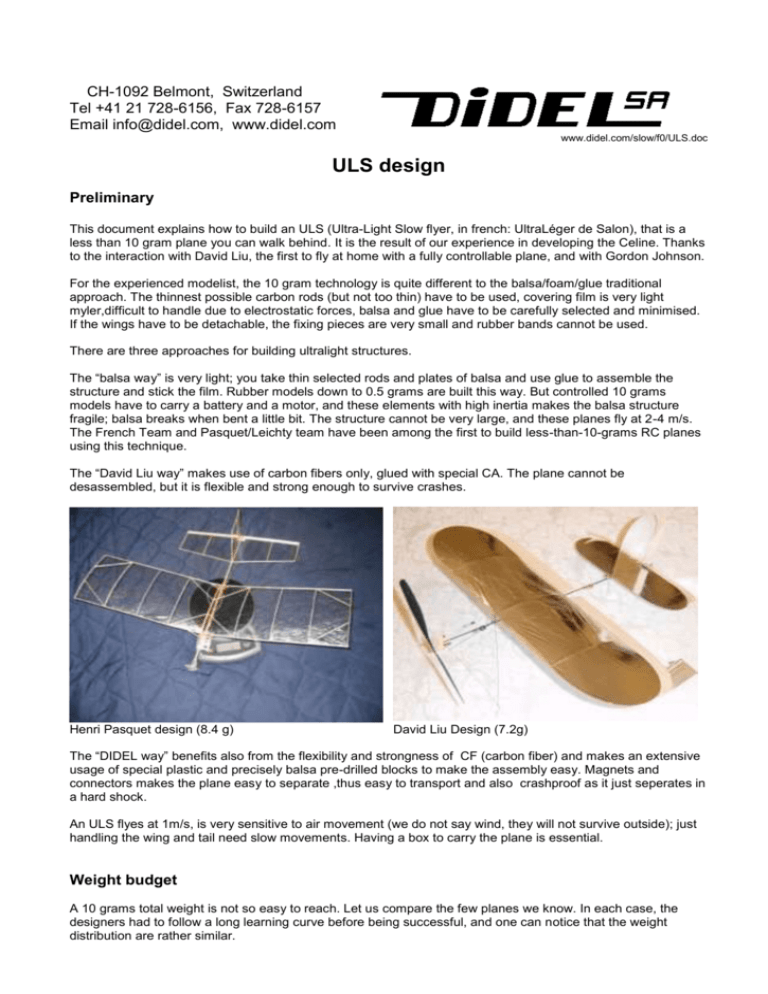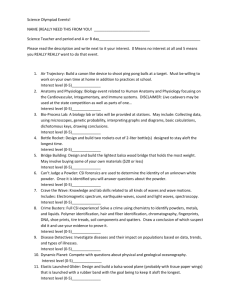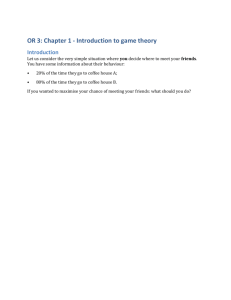ULS
advertisement

CH-1092 Belmont, Switzerland Tel +41 21 728-6156, Fax 728-6157 Email info@didel.com, www.didel.com www.didel.com/slow/f0/ULS.doc ULS design Preliminary This document explains how to build an ULS (Ultra-Light Slow flyer, in french: UltraLéger de Salon), that is a less than 10 gram plane you can walk behind. It is the result of our experience in developing the Celine. Thanks to the interaction with David Liu, the first to fly at home with a fully controllable plane, and with Gordon Johnson. For the experienced modelist, the 10 gram technology is quite different to the balsa/foam/glue traditional approach. The thinnest possible carbon rods (but not too thin) have to be used, covering film is very light myler,difficult to handle due to electrostatic forces, balsa and glue have to be carefully selected and minimised. If the wings have to be detachable, the fixing pieces are very small and rubber bands cannot be used. There are three approaches for building ultralight structures. The “balsa way” is very light; you take thin selected rods and plates of balsa and use glue to assemble the structure and stick the film. Rubber models down to 0.5 grams are built this way. But controlled 10 grams models have to carry a battery and a motor, and these elements with high inertia makes the balsa structure fragile; balsa breaks when bent a little bit. The structure cannot be very large, and these planes fly at 2-4 m/s. The French Team and Pasquet/Leichty team have been among the first to build less-than-10-grams RC planes using this technique. The “David Liu way” makes use of carbon fibers only, glued with special CA. The plane cannot be desassembled, but it is flexible and strong enough to survive crashes. Henri Pasquet design (8.4 g) David Liu Design (7.2g) The “DIDEL way” benefits also from the flexibility and strongness of CF (carbon fiber) and makes an extensive usage of special plastic and precisely balsa pre-drilled blocks to make the assembly easy. Magnets and connectors makes the plane easy to separate ,thus easy to transport and also crashproof as it just seperates in a hard shock. An ULS flyes at 1m/s, is very sensitive to air movement (we do not say wind, they will not survive outside); just handling the wing and tail need slow movements. Having a box to carry the plane is essential. Weight budget A 10 grams total weight is not so easy to reach. Let us compare the few planes we know. In each case, the designers had to follow a long learning curve before being successful, and one can notice that the weight distribution are rather similar. Frequently, the elements are not as easily separable as on the Celine, and weight has to be estimated. Model Body Landing gear Wings Propulsion Tail and actuators Receiver Battery Total Wing area Wing loading French team “Moins que rien” 0.98 0.24 1.16 1.29 1.02 2.26 1.96 8.91 8.2 dm2 1.1 g/dm2 David Liu “Cherub” Gordon Johnson “NanoMücke” 0.4 0.82 0.11 0.18 0.43+0.6 aileron bird 1.43 1.75 1.61 1.24 1.23 0.95 1.13 1.72 2.2 7.2 8.6 3.8 dm2 9,.0 dm2 1.9 g/dm2 0.96 g/dm2 DIDEL “Celine” 0.8 0.28 1.9 1.55 1.65 1.4 1.95 9.53 9.4 dm2 1.1 g/dm2 Note: Celine uses 12 magnets (0.53g) and 3 connectors (0.3 g) thus being crash-proof and easily transportable. All these planes use the Kokam 45 mAh Li-Poly battrery, these are essential with the 4mm pager motors used to make a less than 10 gram model fly. But all the other parts had to be self-developed, and only very few sources exists for ultralight receivers and actuators. The Celine kit has the advantage in useing well designed components to quickly build and fly a very slow ultralight and robust plane. Crashes and repair As it can be seen on the Celine videos, a well designed ULS with detachable wings and battery survives all crashes against a regular surface. The most delicate part is the covering, this can be torn during with uncareful manipulation, and the balsa propeller when the shock occurs with motor at full speed. The covering is repaired with small strips of cellotape. The propeller can be glued with CA several times before being replaced. Frame technology We believe the only way to build an ultralight slow flyer is to use carbon rods. Balsa could be lighter if built by experts, but is terribly brittle. Carbon tubes and rods gives the plane a flexiblity that makes it crash proof. The wing and tail frame is covered with a very thin polyester film, fragile, but easy to repair. Magnets are used to hold the wings, making the transportation easy. The accumulator is also maintained by magnets (Bahoma system), simplifying the on/off procedure and the change of accumulators. Didel has also developed for the Celine kit a convenient charger for the Bahoma compatible LiPoly accus. Body construction – weight budget 0.8 – 1 g 1.2 and 1.7 mm carbon tubes from Wes Technik are robust and of an adequate weight. Carbon rod is too heavy (or too flexible) for a fuselage. Balsa tube is possible, but brittle. A solid fuselage is too heavy. To hold the elements, the simplest way is to insert balsa blocks on the carbon tube. Gluing frame elements without precisely predrilled blocks is delicate and rather heavy. Blocks holding pieces by friction has the other advantage that glueing the element can be made only after the trimming initial flights. As a general rule, one should use as little glue as possible, and no glue at all when elements hold well enough by friction, due to very precise components. The hand develop easily 100 grams when pushing a piece – the force in flight will be only a few grams. CA glue has to be carefully selected: thin and thick are not for the same cases. Contact glue, white glue, etc. So much would have to be said about all these glues, where, when and how to use them. Any good web reference? Landing gear – weight budget 0.15 - 0.25 g The landing gear is made of two or three carbon rods. The triangle is the best, since the horizontal rod can be thin and serves as a robust axle. Two rods are more elegant, but thicker (and heavier) rods must be used. The elasticity is good for absorbing landing shocks, but with too much elasticity the propeller may touch the ground too easily. The wheels are cut out of thin carbon foil, 1mm Depron or 1mm balsa plywood. The problem is the shaft; you need a lathe to machine something clean; a bore in a hard balsa block is a dirty short life solution. Didel has developed special plastic molded shafts for the Celine wheels (not available separately). Gordon Johnson design Celine gearbox and propeller Propulsion system – weight budget 1.2 - 1.5 g Weight constraints force the usage of a 4mm pager motor. A 10 Ohm coil is perfect for getting enough power from a LiPoly accu, but a large propeller (16 to 18 cm) is required to get enough thrust, using an adequate gear box. Good if you find the gears and can precisely machine a light dual stage carter. Didel has invested in gears and gearboxes to serve the slow flyer community. The 4R21 or 4R26 box with a 0.5g 16-18 cm propeller are optimal for a 10g ULS. The thrust is in the 6-8 grams range, allowing a slow high drag flight. A special gearbox (4Rs21) has been designed specifically for the Celine (and not available separately) to be compatible with the 1.7mm carbon tube; in addition, a 5 degree tilt is adjustable for compensating the propeller torque. No commercial propeller exists in the required weight (0.5g) and size (15 to 18 cm). One solution is to mold a carbon foil on a bottle and cut the propeller shape from that. Balsa can be easily formed on a correctly shaped block. The Didel propeller connectors makes it easy to use the propeller with the correct angle, and makes changing the propeller so easy. Wings – weight budget 1 – 1.5g Several options exist for the wing. For 60 cm span, we recommend 0.7 mm carbon rod. Thinner rod could be used if a biplane is built. A curved profile is clearly better than a flat one. Ultra light ribs are formed in balsa, but the technique is not easy to master. Covering is a challenge when the correct procedure has not been explained, and adequate gabarits are essentials to get a good tensions. The Celine has separable wings thanks to very small plastic pieces that includes the magnets. This allows the wings to pack in a small sized box, along with the fusalage and all other bits and pieces . Tail and actuators – weight budget 1 to 1.7g The tail must be as light as possible. This is not so easy, because it consists of many parts due to the moving surfaces. Finding the best proportions between the moving surface, compensation areas and power of the magnetic actuator is not an easy job. It is easy to get something flying, but not easy to find a light, easy to built and efficient solution. For the Celine, we have tried 10 different V and Ttails,sometimes they would work as expected other times not. Implementing the magnetic actuator as a BIRD (Built-In Ruder Device) or as a distant actuator linked with push-rods to the flaps is more a question of taste and personal experience. Technically, the Bird is lighter but solutions for having well aligned hinges have to be found. Push-rods give more freedom for designing the flaps, but low friction hinges are a problem, and adjustable push-rods that do not fall on the ground when they should not are still on our wish-list. Receiver and battery – weight budget 3-3.5g With a 1.7g battery, the reciever, drivers and wires must be 1.5 g maximum. Very few recievers are available in this range. The receiver is fixed to the fuselage. The battery is fixed on a separate movable balsa block, in order to adjust the center of gravity. We use connectors and magnets for holding the battery. This adds 0.4 grams, but is so convenient. jdn/02.04.2003 04.04.03/us








